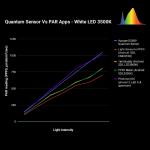While looking over some LED videos this morning, I came across a video extolling the utility of the Photone App (formerly called Korona but rebranded for obvious reasons.) Seems decent but I don't have a quantum sensor to measure it against. It purports to be a PAR meter on your phone.
It's free and the Android version does not require a diffuser component (see video or website), the Apple iOS does. If you don't have a PVC bit or a PVC cutter (again, see video), I found the screw-off cap of a handheld flashlight replaces that very easily. You can also calibrate the app if it seems to not match within reason. Also measures DLI, Kelvin, and lumens.
Anyone who has a quantum sensor and a minute to download the app and try it out want to give us another source for reference?
https://www.youtube.com/watch?v=t0umUgrS_UE
https://growlightmeter.com/
At best, I was 17" below from the center of my flower 240w Viparspectra QB, running at 40%, and read 180 ppfd. DLI of 4.1. It read 3900K no matter which light I put it under.
So if this is to be believed, I'm not putting out a whole lot of energy but my gut and eyes are telling me I'm obliterating my plants currently. Obviously other factors play into this (veg time, container size, nute balance, and environment)
Interested to see if anyone can confirm how accurate this is.
It's free and the Android version does not require a diffuser component (see video or website), the Apple iOS does. If you don't have a PVC bit or a PVC cutter (again, see video), I found the screw-off cap of a handheld flashlight replaces that very easily. You can also calibrate the app if it seems to not match within reason. Also measures DLI, Kelvin, and lumens.
Anyone who has a quantum sensor and a minute to download the app and try it out want to give us another source for reference?
https://www.youtube.com/watch?v=t0umUgrS_UE
https://growlightmeter.com/
At best, I was 17" below from the center of my flower 240w Viparspectra QB, running at 40%, and read 180 ppfd. DLI of 4.1. It read 3900K no matter which light I put it under.
So if this is to be believed, I'm not putting out a whole lot of energy but my gut and eyes are telling me I'm obliterating my plants currently. Obviously other factors play into this (veg time, container size, nute balance, and environment)
Interested to see if anyone can confirm how accurate this is.




